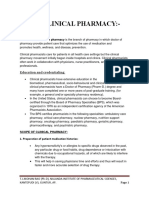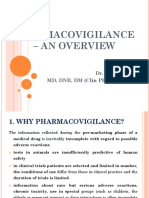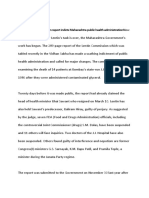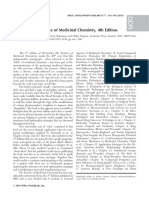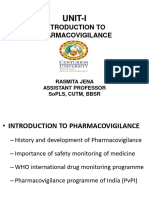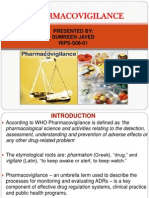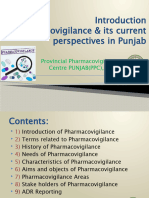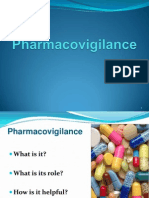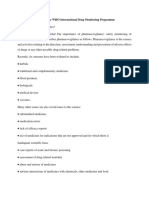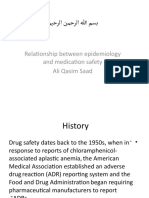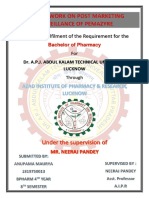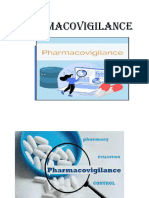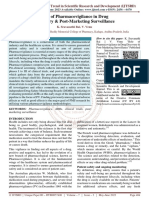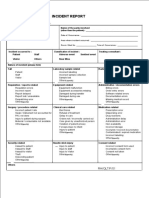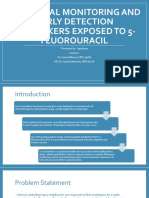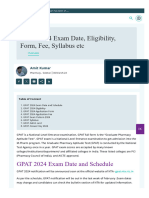Pharmacovigilance Report MAIN-1
Pharmacovigilance Report MAIN-1
Uploaded by
9Asfara AzeezCopyright:
Available Formats
Pharmacovigilance Report MAIN-1
Pharmacovigilance Report MAIN-1
Uploaded by
9Asfara AzeezOriginal Title
Copyright
Available Formats
Share this document
Did you find this document useful?
Is this content inappropriate?
Report this DocumentCopyright:
Available Formats
Pharmacovigilance Report MAIN-1
Pharmacovigilance Report MAIN-1
Uploaded by
9Asfara AzeezCopyright:
Available Formats
Practice
school Dept
INTRODUCTION AND OVER VIEW OF
PHARMACOVIGILANCE
Pharmacovigilance (PV, or PhV), also known as drug safety, is the pharmaceutical
science relating to the "collection, detection, assessment, monitoring, and prevention"
of adverse effects with pharmaceutical products. The etymological roots for the word
"pharmacovigilance" are: pharmakon (Greek for drug) and vigilare (Latin for to keep watch).
As such, pharmacovigilance heavily focuses on adverse drug reactions (ADR). PV was
officially introduced in December 1961 with the publication of a letter in The Lancet by Dr.
William McBride, the Australian obstetrician who first suspected a causal link between
serious fatal deformities (phocomelia), thalidomide used during pregnancy: Thalidomide was
used as an anti-emetic and sedative agent in pregnant women.
HISTORICAL BACKGROUND
•The safety of drug was not the early concern in the history of drug.
•The thalidomide tragedy of 1960s opened the eyes of drug regulators as well as other
concern healthcare professionals to establish a way to ensure drug safety.
•The mile stone in the drug safety was the publication of chloroform related death on The
Lancet journal for the first time in 1893.
•The US FDA act was passed in 1906 for the first time, but it was amended to control
misbranding of ingredients and false advertising claims after 107 deaths by the use of di-
ethylene glycol as a solvent for sulphanilamide elixir.
•There were radical changes in the drug safety issues after the worldwide thalidomide
tragedy which was first reported by an Australian obstetrician, Dr. William McBride in
December 1961.
PURPOSE OF PV
PV is the science and activities related to the detection, assessment, understanding and
prevention of ADRs or any other possible drug-related problems. Recently, its concerns have
been widened to include:
Crescent college of pharmaceutical sciences
Practice
school Dept
1. Herbals Traditional and complementary medicines
2. Blood products
PAGE 1
3. Biological products
4. Medical devices
5. Vaccines
THE SPECIFIC AIMS OF PV ARE TO :
1. Improve patient care and safety in relation to the use of medicines and all medical and
paramedical interventions
2. Improve public health and safety in relation to the use of medicines
3. Contribute to the assessment of benefit, harm, effectiveness and risk of medicines
encouraging their safe, rational and more effective (including cost-effective) use, and
4. Promote understanding, education and clinical training in PV and its effective
communication to the public.
Pharmacovigilance Programme of India (PvPI):
A National PV Centre is located in the Department of Pharmacology, All India Institute of
Medical Sciences (AIIMS), New Delhi and two WHO special centres are located in Mumbai
(KEM Hospital) and Aligarh (JLN Hospital). These centres were to report ADRs to the drug
regulatory authority of India. The major role of these centres was to monitor ADRs to
medicines marketed in India. The Central Drugs Standard Control Organization (CDSCO),
Directorate General of Health Services under the aegis of Ministry of Health & Family
Welfare, Government of India in collaboration with Indian Pharmacopeia Commission (IPC),
Ghaziabad, (U.P.) is initiating a nation-wide PV programme for protecting the health of the
Crescent college of pharmaceutical sciences
Practice
school Dept
patients by assuring drug safety. The programme shall be coordinated by the IPC as a
National Coordinating Centre (NCC).
STANDARD TERMS AND TERMINOLOGIES USED IN PV
1. Adverse Drug Event (ADE): Any unwanted or harmful effect experienced by a patient
while taking a medication, whether or not it is considered to be related to the drug's use.
ADEs can range from mild side effects to serious adverse reactions.
2. Adverse Drug Reaction (ADR): An adverse reaction to a medication that occurs at normal
doses used for prophylaxis, diagnosis, or therapy. ADRs are typically dose-dependent and
more commonly observed than ADEs.
3. Serious Adverse Event (SAE): An adverse event that results in death, hospitalization,
persistent or significant disability, congenital anomaly/birth defect, or requires medical or
surgical intervention to prevent any of these outcomes.
4. Drug Safety Monitoring: The ongoing process of collecting, monitoring, analyzing, and
evaluating data on the safety profile of drugs in order to detect and assess adverse events,
establish causality, and manage risks.
5. Signal Detection: The systematic process of identifying potential new safety concerns or
signals of unknown adverse effects associated with a specific drug or drug class. Signal
detection involves the analysis of aggregated adverse event data and other available
information.
6. Pharmacovigilance Database: A repository where adverse drug event reports and related
information are collected, stored, and analyzed. These databases play a crucial role in signal
detection, risk assessment, and ongoing drug safety monitoring.
Crescent college of pharmaceutical sciences
Practice
school Dept
PAGE 3
8. Risk Management: The application of strategies and measures to minimize or mitigate the
risks associated with the use of a medication. This may include labeling changes, prescribing
restrictions, educational interventions, additional monitoring, or even withdrawal of the drug
from the market if necessary.
9.Post-Marketing Surveillance: The ongoing monitoring and assessment of the safety and
effectiveness of drugs after they have been approved and made available in the market. Post-
marketing surveillance involves the collection of real-world data on drug use and the
detection of ADEs or newly emerging safety concerns.
DIFFERENT SCALES USED IN ADR MONITORING
Causality assessment in pharmacovigilance involves evaluating the likelihood of a drug
causing an adverse event. The WHO Uppsala Monitoring Centre (UMC) scale and the
Naranjo Adverse Drug Reaction Probability Scale are commonly used tools for this purpose.
WHO-UMC SCALE
The WHO UMC scale categorizes causality into six levels, ranging from “certain” to
“unlikely” and “unclassified.” It considers factors such as temporal relationship, alternative
explanations, dechallenge/rechallenge data, and dose-response relationship.
NARANJO SCALE
Naranjo scale is a questionnaire-based tool that assigns points based on various criteria, such
as the temporal relationship, dechallenge/rechallenge, and the presence of risk factors. The
total score classifies the causality as “definite,” “probable,” “possible,” or “doubtful.”
Both scales aid in systematically assessing and grading the likelihood of a drug’s
involvement in an adverse event during pharmacovigilance processes.
Crescent college of pharmaceutical sciences
Practice
school Dept
INFORMATION RESOURCES IN PHARMACOVIGILANCE
PAGE 4
1. **FDA Adverse Event Reporting System (FAERS):** The FDA's database containing
adverse event reports submitted by healthcare professionals, consumers, and manufacturers.
2. **EudraVigilance:** The European Medicines Agency's (EMA) database, collecting and
managing reports of suspected adverse drug reactions in the European Economic Area.
3. **WHO Global Individual Case Safety Reports (ICSRs) database:** A global repository
of individual case safety reports managed by the WHO, providing a comprehensive view of
adverse events on a global scale.
4. **PubMed/MEDLINE:** A valuable database for scientific literature, including peer-
reviewed articles, reviews, and studies related to drug safety and pharmacovigilance
MEDICAL EVALUATION OF ADR
A comprehensive ADR-monitoring and reporting program should be an integral part of an
organization's overall drug use system. An ADR-monitoring and reporting program should
include the following features:
1. The program should establish
(a.) An ongoing and concurrent (during drug therapy) surveillance system based on the
reporting of suspected ADRs by pharmacists, physicians, nurses, or patients.
Crescent college of pharmaceutical sciences
Practice
school Dept
(b.) A prospective (before drug therapy) in
surveillance system for high-risk drugs or patients with a high risk for ADRs.
• (c.) A concurrent surveillance system for monitoring alerting orders. Alerting orders include
the use of "tracer" drugs that are used to treat common ADRs (e.g., orders for immediate
PAGE
doses of antihistamines, epinephrine, and corticosteroids), abrupt discontinuation or 5
decreases
in dosage of a drug, or stat orders for laboratory assessment of therapeutic drug levels.
• 2. Prescribers, caregivers, and patients should be notified regarding suspected ADRs.
• 3. Information regarding suspected Huy should be reported to the pharmacy for complete
data collection• 4. High-risk patients should be identified and monitored. High-risk patients
include but are not limited to pediatric patients, geriatric patients, patients with organ failure
(e.g., hepatic or renal failure), and patients receiving multiple drugs.
• 5. Drugs likely to cause ADRs ("high-risk" drugs) should be identified, and their use should
be monitored.
Examples of drugs that may be considered as high risk include aminoglycosides,
amphotericin, antineoplastics, corticosteroids, digoxin, heparin, lidocaine, phenytoin,
theophylline, thrombolytic agents, and warfarin.
• 6. The cause(s) of each suspected ADR should be evaluated on the basis of the patient's
medical and medication history, the circumstances of the adverse event, the results of
dechallenge and rechallenge (if any), alternative etiologies, and a literature review.
BENEFITS
• An ongoing ADR-monitoring and reporting program can provide benefits to the
organization, pharmacists, other health care professionals, and patients. These benefits
include (but are not limited to) the following:
• 1. Providing an indirect measure of the quality of pharmaceutical care through identification
of preventable ADRs and anticipatory surveillance for high-risk rugs or patients.
Crescent college of pharmaceutical sciences
Practice
school Dept
• 2. Complementing organizational risk-management activities and efforts to minimize
liability.
• 3. Assessing the safety of drug therapies, especially recently approved drugs.
• 4. Measuring ADR incidence.
PAGE 6their
• 5. Educating health care professionals and patients about drug effects and increasing
level of awareness regarding ADRS.
• 6. Providing quality-assurance screening findings for use in drug-use evaluation programs.
• 7. Measuring the economic impact of ADR prevention as manifested through reduced
hospitalization, optimal and economical drug use, and minimized organizational liability.
MANAGEMENT
• Rapid action is sometimes important because of the serious nature of a suspected adverse
drug reaction, forexample anaphylactic shock. Emergency treatment and withdrawal of all
medicines is occasionally essential, in which case cautious reintroduction of essential
medicines should be considered. Otherwise, using clinical benefit-risk judgment, together
with help from investigations, one
• decides which medicine or medicines should be with drawn as a trial. A problem
immediately arises if one or more of the medicines is essential to the patient. If the culprit is
fairly clear, a benefit-risk decision needs to be taken about the need for the drug (are there
equally effective substitutes that are unlikely to produce the same adversedrug reaction?), the
severity of the reaction, and its potential for treatment. If several medicines could be
causative, the non-essential medicines should be withdrawn first preferably one at a time,
depending on the severity of the reaction. If the reaction is likely to be dose related, dose
reduction should be considered.
Many prescribers unnecessarily withhold a drug when interactions are suspected, rather than
adjusting the dose.
• The patient should be observed during withdrawal. The waiting period will vary, depending
on the rate of elimination of the drug from the body and the type of pathology.
Crescent college of pharmaceutical sciences
Practice
school Dept
ROLE OF PHARMACIST
• Pharmacists should exert leadership in the development, maintenance, and ongoing
evaluation of ADR programs. They should obtain formal endorsement or approval of such
programs through appropriate committees (e.g., a pharmacy and therapeutics committee and
the executive committee of the medical staff) and the organization's administration. In
settings where applicable, input into the design of the pro-gram should be obtainedPAGE
from7 the
medical staff, nursing staff, quality improvement staff, medical records department, and risk
managers.
• The pharmacist should facilitate
• 1. Analysis of each reported ADR,
• 2. Identification of drugs and patients at high risk for being involved in
ADRS,
• 3. The development of policies and procedures for the ADR-monitoring and reporting
program,
• 4. A description of the responsibilities and interactions of pharmacists, physicians, nurses,
risk managers, and other health professionals in the ADR program,
• 5. Use of the ADR program for educational purposes,
• 6. Development, maintenance, and evaluation of ADR records within the organization,
• 7. The organizational dissemination and use of information obtained through the ADR
program,
• 8. Reporting of serious ADRs to the FDA or the manufacturer (or both),
ADVERSE EVENT REPORTING SYSTEM
Adverse event is defined as unanticipated and unwanted response to medical intervention
during the perioperative period that can threaten patient wellbeing. Respiratory adverse
events are any episodes of desaturation, partial or complete airway obstruction, persistent
coughing, breath holding and bron-chospasm (1-3). Despite improvements in pediatrics
Crescent college of pharmaceutical sciences
Practice
school Dept
anesthesia, respiratory adverse events are still the most frequent cause of serious morbidity
and mortality in the peri-operative period. The 3/4th of all critical incidents and the 1/31d of
all perioperative cardiac arrests in pediatric anesthesia are caused by respiratory adverse
events. Preoperative identification of those children at high risk is a challenging process (4,
5). Children are vulnerable to respiratory adverse events because of anatomical and
physiological considerations and frequent respiratory tract infections.
Inconsistent definitions of respiratory adverse events among studies make comparisons
difficult and results in discrepancy on magnitude of the actual events (1). Despite
introduction of new monitoring modalities, pharmacological products and new clinical
practice guide-lines, the prevalence of respiratory adverse events has remained high and
increased length of hospital stay and medical costs .
The patient's age, techniques of anesthesia induction, comorbidities and airway surgery were
strongly associated with increased occurrence of adverse events during surgery.
MEDICAL EVALUATION OF ADR
A comprehensive ADR-monitoring and reporting program should be an integral part of an
organization's overall drug use system. An ADR-monitoring and reporting program should
include the following features:
1. The program should establish
(a.) An ongoing and concurrent (during drug therapy) surveillance system based on the
reporting of suspected ADRs by pharmacists, physicians, nurses, or patients.
(b.) A prospective (before drug therapy) in
surveillance system for high-risk drugs or patients with a high risk for ADRs.
• (c.) A concurrent surveillance system for monitoring alerting orders. Alerting orders include
the use of "tracer" drugs that are used to treat common ADRs (e.g., orders for immediate
Crescent college of pharmaceutical sciences
Practice
school Dept
doses of antihistamines, epinephrine, and corticosteroids), abrupt discontinuation or decreases
in dosage of a drug, or stat orders for laboratory assessment of therapeutic drug levels.
• 2. Prescribers, caregivers, and patients should be notified regarding suspected ADRs.
• 3. Information regarding suspected Huy should be reported to the pharmacy for complete
data collection• 4. High-risk patients should be identified and monitored. High-risk patients
include but are not limited to pediatric patients, geriatric patients, patients with organ failure
(e.g., hepatic or renal failure), and patients receiving multiple drugs.
• 5. Drugs likely to cause ADRs ("high-risk" drugs) should be identified, and their use should
be monitored.
Examples of drugs that may be considered as high risk include aminoglycosides,
amphotericin, antineoplastics, corticosteroids, digoxin, heparin, lidocaine, phenytoin,
theophylline, thrombolytic agents, and warfarin.
• 6. The cause(s) of each suspected ADR should be evaluated on the basis of the patient's
medical and medication history, the circumstances of the adverse event, the results of
dechallenge and rechallenge (if any), alternative etiologies, and a literature review.
BENEFITS
• An ongoing ADR-monitoring and reporting program can provide benefits to the
organization, pharmacists, other health care professionals, and patients. These benefits
include (but are not limited to) the following:
• 1. Providing an indirect measure of the quality of pharmaceutical care through identification
of preventable ADRs and anticipatory surveillance for high-risk rugs or patients.
• 2. Complementing organizational risk-management activities and efforts to minimize
liability.
• 3. Assessing the safety of drug therapies, especially recently approved drugs.
• 4. Measuring ADR incidence.
• 5. Educating health care professionals and patients about drug effects and increasing their
level of awareness regarding ADRS.
Crescent college of pharmaceutical sciences
Practice
school Dept
• 6. Providing quality-assurance screening findings for use in drug-use evaluation programs.
• 7. Measuring the economic impact of ADR prevention as manifested through reduced
hospitalization, optimal and economical drug use, and minimized organizational liability
MANAGEMENT
• Rapid action is sometimes important because of the serious nature of a suspected adverse
drug reaction, forexample anaphylactic shock. Emergency treatment and withdrawal of all
medicines is occasionally essential, in which case cautious reintroduction of essential
medicines should be considered. Otherwise, using clinical benefit-risk judgment, together
with help from investigations, one
• decides which medicine or medicines should be with drawn as a trial. A problem
immediately arises if one or more of the medicines is essential to the patient. If the culprit is
fairly clear, a benefit-risk decision needs to be taken about the need for the drug (are there
equally effective substitutes that are unlikely to produce the same adversedrug reaction?), the
severity of the reaction, and its potential for treatment. If several medicines could be
causative, the non-essential medicines should be withdrawn first preferably one at a time,
depending on the severity of the reaction. If the reaction is likely to be dose related, dose
reduction should be considered.
Many prescribers unnecessarily withhold a drug when interactions are suspected, rather than
adjusting the dose.
• The patient should be observed during withdrawal. The waiting period will vary, depending
on the rate of elimination of the drug from the body and the type of pathology.
ROLE OF PHARMACIST
• Pharmacists should exert leadership in the development, maintenance, and ongoing
evaluation of ADR programs. They should obtain formal endorsement or approval of such
programs through appropriate committees (e.g., a pharmacy and therapeutics committee and
the executive committee of the medical staff) and the organization's administration. In
settings where applicable, input into the design of the pro-gram should be obtained from the
medical staff, nursing staff, quality improvement staff, medical records department, and risk
managers.
Crescent college of pharmaceutical sciences
Practice
school Dept
• The pharmacist should facilitate
• 1. Analysis of each reported ADR,
• 2. Identification of drugs and patients at high risk for being involved in
ADRS,
• 3. The development of policies and procedures for the ADR-monitoring and reporting
program,
• 4. A description of the responsibilities and interactions of pharmacists, physicians, nurses,
risk managers, and other health professionals in the ADR program,
• 5. Use of the ADR program for educational purposes,
• 6. Development, maintenance, and evaluation of ADR records within the organization,
• 7. The organizational dissemination and use of information obtained through the ADR
program,
• 8. Reporting of serious ADRs to the FDA or the manufacturer (or both).
ADVERSE EVENT REPORTING SYSTEM AND FORMS
ADR reporting is an integral element in drug safety surveillance and pharmacovigilance.
Spontaneous ADR reporting: a passive surveillance system in which health professionals are
encouraged to report drug related ADRs directly to the regulatory authority or the company
marketing the suspected product on a voluntary basis.
Who can report?
1) All health care professionals- clinicians, pharmacists, nurses, physician etc.
2) All non-health care professionals- consumers/patients.
What to report?
• All type of suspected ADRs- known/unknown, serious/non-serious, frequent/rare.
Crescent college of pharmaceutical sciences
Practice
school Dept
• Reaction from all types of pharmaceutical products- allopathy, Ayurveda, vaccines, medical
devices etc.
• Suspected drug interactions.
• Unexpected ADRs- reactions not found in product information/labelling.
When the reaction causes death.
• Life threatening reactions.
• Hospitalization.
• Disability.
• Congenital anomaly.
Whom to report?
• Peripheral pharmacovigilance center- a primary ADR information gathering center where
ADRs are recognized and synchronized by RPCs.
• Regional pharmacovigilance center- a secondary center, usually in medical colleges with
relatively larger facilities.
• Zonal pharmacovigilance center- a tertiary center, identified by CDSCO.
How and where to report?
• Use 'suspected ADR reporting form/Medicine side effect reporting form' available on
official website of IPC and CDSCO.
• Filled ADR form submitted to the nearest ADR monitoring center (AMC) or directly to
NCC-PvPI.
• ADR can be even reported through phone calls on Helpline (toll free) 1800 180 304.
What happens to the submitted information?
• ADR reports from various sources are collected at AMCs. Staffs study, validate and
prioritize the report and performs provisional causality assessment using WHO-UMC scale.
Crescent college of pharmaceutical sciences
Practice
school Dept
• A record of all activities maintained as per the standard watch list.
• Analyzed forms forwarded to NCC through ADR databases.
• Data analyzed and forwarded to Global pharmacovigilance database managed by WHO
Uppsala monitoring center, Sweden.
• Integrated ADR data transferred through Vigi-Flow to UMC database.
• UMC team analyses submitted data and detects signal and communicate with NCC-PvPI
ADR reporting form.
* An ADR reporting form is used for collecting information about a suspected adverse event
Crescent college of pharmaceutical sciences
Practice
school Dept
for analysis at a National Pharmacovigilance .
Crescent college of pharmaceutical sciences
Practice
school Dept
Crescent college of pharmaceutical sciences
Practice
school Dept
DRUG DICTIONARIES AND DRUG CODING
DRUG DICTIONARIES
increased work of breathing, particularly during expiration and wheezing on auscultation or
requires bronchodilators
The World Health Organization Drug Dictionary
This contains of the order of 45 000 proprietary drug names, with about 2600 being added
annually (Uppsala Monitoring Centre, 2002). It is an international classification, giving
thenames used in different countries, together with all active ingredients with unique
reference numbers. Drugs are classified according to ATC code. The dictionary was started in
1968 and includes all drugs mentioned on adverse reaction reports submitted under the World
Health Organization (WHO) Programme on International Drug Monitoring. Drugs
fromalmost 70 countries are represented, and updates are issued quarterly.
Coding Symbols for a Thesaurus of Adverse Reaction Terms
Crescent college of pharmaceutical sciences
Practice
school Dept
This terminology was distributed by the US Food and Drugs Administration (FDA) and has
been widely used by companies for coding adverse events in clinical trials and
postmarketingsurveillance. However, its small size has resulted in many organizations
producing their own customized versions, by the addition of new terms. At the top of the
COSTART (Food and Drugs Administration, 1989) hierarchy, there are 12 body systems.
At the next lowest level in COSTART, there is a mid-level classification for
retrieval purposes based on pathophysiology. Coding symbols are associated with one or
more Glossary terms, which are used to assist in selection of the Coding symbol when
coding. For example, for the Coding symbol ANGINA PECTORIS, we have Glossary terms
including Angina at rest Prinzmetal’s; Angina attack; Angina of effort; Angina pectoris;
Angina pectoris aggravated; Anginalpain; Anginal syndrome; Effort angina; etc.
Crescent college of pharmaceutical sciences
Practice
school Dept
QUALITY SYSTEMS IN PHARMACOVIGILANCE
Quality systems in pharmacovigilance are critical for ensuring the systematic and
standardized processes that are essential for monitoring, assessing, and reporting adverse
events related to medications. These systems are designed to maintain the highest standards
of medication safety and to comply with regulatory requirements.
Quality cycle
The quality system shall be based on all of the following activities:
a)Quality planning: Establishing structures and planning integrated and consistent processes.
b)Quality adherence: Carrying out tasks and responsibilities in accordance with quality
requirements.
c)Quality control and assurance: Monitoring and evaluating how effectively the structures
and processes have been established and how effectively the processes are being carried out.
Crescent college of pharmaceutical sciences
Practice
school Dept
d)Quality improvements: Correcting and improving the structures and processes where
necessary
Quality system and record management practices:
The organisation should assign the specific responsibilities for the pharmacovigilance audit
activities. Pharmacovigilance audit activities should be independent. The organisation's
management should ensure this independence and objectivity in a structured manner and
document this.
Auditors should be free from interference in determining the scope of auditing, performing
pharmacovigilance audits and communicating audit results. The main reporting line should be
to the upper management with overall responsibility for operational and governance structure
that allows the auditor(s) to fulfil their responsibilities and to provide independent, objective
audit opinion. Auditors can consult with technical experts, personnel involved in
pharmacovigilance processes, and with the person responsible for pharmacovigilance;
however auditors should maintain an unbiased attitude that allows them to perform audit
work in such a manner that they have an honest belief in their work product and that no
significant quality compromises are made. Objectivity requires auditors not to subordinate
their judgement on audit matters to that of others.
Specific quality system procedures and processes
● Compliance management by marketing authorization holders
● Compliance management by competent authorities
● Record management
● Documentation of quality system
● Additional quality system documentation by marketing authorization Holders
● Monitoring of the performance and effectiveness of the pharmacovigilance system
and its quality system.
Crescent college of pharmaceutical sciences
Practice
school Dept
PHARMACOVIGILANCE DATA BASE AND SIGNAL
DETECTION
Pharmacovigilance database
pharmacovigilance database (safety database) is software that is used to store adverse event
(AE), adverse drug reaction (ADR), serious adverse event (SAE), suspected serious adverse
drug reaction (SUSAR) and pregnancy reports during clinical trials (CT)or when a
pharmaceutical company has a marketing authorization (licence) for a medicinal product.
Examples of pharmacovigilance databases include :
ARGUS, ARIS-G, AERS, SAFIRE.
Signal
According to WHO signal is “Reported information on a possible causal relationship between
an adverse event and a drug, the relation being unknown or incompletely documented
previously.
Signal detection
Signal detection in pharmacovigilance is the process of actively searching for and identifying
safety signals from a wide variety of data sources. It involves the identification of potential
Crescent college of pharmaceutical sciences
Practice
school Dept
safety signals or unexpected patterns of adverse events that may indicate a previously
unrecognised safety concern associated with a medication.
Signals are reported to regional pharmacovigilance centre followed by zonal center. Finally,
all case reports are filed in databases at the National centers as well as sent onto the UMC.
Importance of signal detection
● To identify potential safety concern
● To improve patient outcome
● Enhancing drug development
● Regulatory compliance
● To reduce healthcare cost
● To increase public confidence
Methods of signal detection
2 methods are used :
1. Traditional pharmacovigilance method
2. Data mining algorithm
Signal assessment
Crescent college of pharmaceutical sciences
Practice
school Dept
The objective of signal assessment is to further evaluate the significance and potential risk of
a validated signal so as to identify the need for additional data collection, risk mitigation or
minimization activities in a timely manner, or for any regulatory action.Assessment is
performed using UMC scale and Naranjo scale of probability to analyse the cause and effect
analysis.
Sufficient data is required to assess the relationship of the drug to event. Inorder to obtain
good quality data various software and techniques are used.
AERS (USA) (Adverse Event Reporting System): AERS is a database that contains
information on adverse event and medication error reports submitted to FDA.
VIGIBASE:The unique WHO global database of reported potential side effects of medicinal
products.
VIGIFLOW (INDIA): ICSRs management system for countries that require an electronic
pharmacovigilance database for the collection, processing and sharing of ICSRs for effective
data analysis.
ARGUS SAFETY DATABASE:It is used to help the companies to ensure compliance with
global regulation regarding pharmacovigilance and other related activities.
EUDRAVIGILANCE:It is the European data processing network and management system
for monitoring the safety of medicines.
RISK ASSESMENT AND MANAGEMENT
Crescent college of pharmaceutical sciences
Practice
school Dept
Risk management in Pharmacovigilance is a global activity to safeguard health of patients.
Risk Management is a set of activities performed for identification of risk, risk assessment,
risk minimization or prevention and risk management. The objective of risk management
strategy is to ensure that the balance of benefits and risks of a medicine remains positive over
the time when it is used in real world settings.
Types of risks:
Identified risk: There is adequate evidence of an association between the medicine and the
risk occurrence.
Potential risk: There is some basis for suspicion of an association between the medicine and
the risk occurrence, but it is not confirmed.
Indicator What for Frequency of
used assessment
Number of ADR reports Process Annually
received in the last year
Number of active Process Every 5 years
surveillance activities
currently ongoing or carried
out in the last five years
Percentage of patients in Process Annually
public health programs for
whom drug-related adverse
events were reported in the
last year (disaggregated by
type of adverse event, drug,
severity, outcomes, and
Crescent college of pharmaceutical sciences
Practice
school Dept
demographics)
Percentage of patients under
going treatment within a
public health program whose
treatment was modified
because of treatment failure
or ADRs in the last year
(disaggregated by treatment
failure and ADRs)
COMMUNICATION IN PHARMACOVIGILANCE
Communication in pharmacovigilance is a conversation between the health care professional
and a patient in which the patient describes their problem or issues related to health, it also
includes the effects or side effects and the information about adverse events of drugs.
Aims of pharmacovigilance
• To provide facility in changing health care practices when needed.
.To provide the facility on informed decision on the rational use of medicines.
• To change the behaviours, attitudes of public in relation to use of drugs
Principles of effective communication
• Specify your group of audience from which you want to communicate.
Crescent college of pharmaceutical sciences
Practice
school Dept
• To choose the right method for communication to patients.
• Make the benefits clear to people.
• To ensure that people should understand the information you are sharing.
• To take feedbacks of ADRs
• To provide a brief knowledge of the benefits of people.
Communication in drug safety crisis management
It is defined as communication or exchange of information between HCP and marketing
authorization holders about AEs of drugs and other information about crises occurring from
the medicines.
Crisis communication is defined as the process of managing strategy, messages and distri-
bution channels which are necessary to communicate effectively with media and employees.
advocacy groups or stakeholders or policy makers for betterment of the product and their
outcomes.
Crisis management- process for preventing the damage a crisis which can inflict on a
company or stakeholders.
Divided into 3 phases:
a) Pre-crisis: prevention of risks which may lead to crisis.
Crescent college of pharmaceutical sciences
Practice
school Dept
b) Crisis response: response form the management after the crisis hits. Divided into 2
sections-initial crisis response and reputation repair and behaviour intentions.
CASE NARRATIVE WRITING
case narrative writing is a process of documenting a patient's medical history, symptoms,
diagnosis, treatment plan, and outcomes. It is an essential part of medical record-keeping and
serves as a reference for healthcare providers in future patient care.
Here are some tips for writing a comprehensive and accurate case narrative:
1. Start with the patient's medical history: Begin by documenting the patient's medical
history, including any past illnesses, surgeries, or hospitalizations.
2. Describe the current symptoms: Document the patient's current symptoms, including when
they started, how severe they are, and any aggravating or alleviating factors.
3. Conduct a physical exam: Perform a physical exam and document any abnormal findings.
4. Order diagnostic tests: Order any necessary diagnostic tests and document the results.
5. Make a diagnosis: Based on the patient's medical history, symptoms, physical exam, and
diagnostic test results, make a diagnosis.
6. Develop a treatment plan: Develop a treatment plan that includes medications, procedures,
and any lifestyle changes.
Crescent college of pharmaceutical sciences
Practice
school Dept
7. Monitor the patient: Monitor the patient's progress, including any adverse reactions to
medications or treatments.
8. Document outcomes: Document the patient's outcomes, including any improvements or
setbacks.
When writing a case narrative, it is essential to be objective, thorough, and accurate. Use
clear, concise language, and avoid medical jargon that may be confusing to non-medical
professionals. Finally, ensure that the narrative follows all legal and ethical guidelines for
medical record-keeping.
GLOBAL PERSPECTIVE IN PHARMACOVIGILANCE
Pharmacovigilance (PV) is the inevitable part of drug discovery and development procedures.
The increasing incidence of Adverse Drug Reactions (ADRs) is expected to accelerate the
demand for PV services. The market is hammered by the appearance of the COVD-19
(coronavirus) pandemic. The evolving threat of COVID-19 infection is affecting businesses,
communities, industries, and lives around the world. Safety reporting and medical monitoring
are necessary as several potential therapies are being used to treat coronavirus induced
infection. The medications like Remdesivir and other old drugs, such as Lopinavir/Ritonavir
and hydroxychloroquine (HCQ), are being used/repurposed to treat coronavirus infection.
The chances of suspected ADRs for some of these medicines have already been submitted to
the individual case safety reports database named VigiBase managed by UMC.
Globally, the concept of PV and drug safety was initiated to prevent the occurrence of
thalidomide like catastrophe. Currently the global PV program is coordinated by Uppsala
monitoring Centre (UMC) Sweden with active coordination and cooperation from member
countries. The National Health Service data from England suggest that during one year in
2015-2016 approximately 56000 imaging was done with various radio isotopes.
Crescent college of pharmaceutical sciences
Practice
school Dept
Safety issues need to be carefully addressed in coherent way, because deformation is gathered
from the different source (premarketing trials, post approval safety studies, spontaneous
report etc.) and from different parts of the world (FDA AERS, vigibase, Eudravigilance).
INIAN PERSPECTIVE IN PHARMACOVIGILANCE
ndia is the fast heading for the distinction of being the global pharmacy of generic drug. India
is world's second most populated country with over billion potential drug consumer and
clinical trials.
irst attempt for formal ADR monitoring system was done in 1986
with involvement of 12 regional centers, each covering population of 50 million, but it was
not a fruitful effort
.After about a decade, in 1997, India collaborated with WHO Uppsala monitoring centre,
Sweden for ADR
reporting but again was not completely successful in implementing effective ADR
monitoring system.
Continuous efforts in this direction finally ended up with the implementation of ‘National
Pharmacovigilance
Program’ [NPP] which became operational from Jan, 2005 , coordinated by Central Drug
Standard Control
Organization [CDSCO], New Delhi under the aegis of ministry of health and family welfare.
[5]NPP had three
goals : short term goal was to foster ADR reporting culture among health care
professionals ;intermediate goal
was to involve large number of healthcare professionals and long term goal was to be a
benchmark for global
drug monitoring. The program established three-tier structure- 2 zonal centers, 5 regional
centers and 28
Crescent college of pharmaceutical sciences
Practice
school Dept
peripheral centers.[11] Peripheral centers were to record all the adverse events and send to
regional centers which
in turn would collate and screen the data from peripheral centers and send it further to zonal
centers for analysis
and further submission to National pharmacovigilance advisory committee
[NPAC] in CDSCO.
egional centers under PVPI
Eastern region - IPGMER, Kolkata
Western region - KEM Hospital, Mumbai
Northern region - PGIMER, Chandigarh
Southern region - JSS Hospital, Mysore
Crescent college of pharmaceutical sciences
Practice
school Dept
ROLE OF PHARMACIST IN ADR MONITORING
Pharmacists play a crucial role in monitoring adverse drug reactions (ADRs). As experts in
medication use and safety, pharmacists are well-positioned to identify and report ADRs, as
well as to counsel patients on potential side effects of their medications.
Here are some of the ways in which pharmacists can contribute to ADR monitoring:
1. Counseling patients: Pharmacists can counsel patients on the potential side effects of their
medications and how to recognize and report ADRs.
2. Detection and reporting: Pharmacists can detect and report ADRs to regulatory authorities,
which helps to identify new or previously unknown ADRs associated with medications.
3. Collaboration with healthcare providers: Pharmacists can collaborate with healthcare
providers to identify and manage ADRs, including recommending alternative medications or
adjusting doses.
4. Education and awareness: Pharmacists can educate patients and other healthcare
professionals about ADRs and the importance of monitoring and reporting them.
Overall, pharmacists play a critical role in ADR monitoring and can contribute to improving
medication safety and patient outcomes.
VACCINE SAFETY SURVEILLANCE
vaccine safety surveillance is the ongoing monitoring of the safety of vaccines after they have
been licensed and approved for use. This process involves the collection and analysis of data
on adverse events following immunization (AEFI), which are any unexpected or unwanted
medical occurrences that happen after vaccination.
Crescent college of pharmaceutical sciences
Practice
school Dept
Vaccine safety surveillance is important to ensure that vaccines continue to be safe and
effective for use in preventing infectious diseases. This process involves several steps,
including:
1. Active monitoring of AEFIs: Health authorities and vaccine manufacturers actively
monitor and investigate reports of AEFIs to identify any potential safety concerns.
2. Regular safety reviews: Health authorities conduct regular safety reviews of licensed
vaccines to assess the ongoing safety of the products.
3. Post-licensure studies: Additional studies may be conducted after a vaccine has been
licensed to gather more information on its safety and effectiveness.
4. Global collaboration: International organizations collaborate to share information on
vaccine safety and to coordinate surveillance efforts.
Overall, vaccine safety surveillance is an important process to ensure that vaccines continue
to be safe and effective for use in preventing infectious diseases.
Crescent college of pharmaceutical sciences
Practice
school Dept
REFERENCES
Meher BR, Agrawal K, Padhy BM. The global perspective of pharmacovigilance in nuclear
medicine practice. Indian Journal of Nuclear Medicine: IJNM: The Official Journal of the
Society of Nuclear Medicine, India. 2018 Oct;33(4):269.
Nandha R. INTERNATIONAL JOURNAL OF DRUG FORMULATION AND RESEARCH
PHARMACOVIGILANCE: INDIAN PERSPECTIVE.2014 Aug 15
Crescent college of pharmaceutical sciences
You might also like
- Clinical Pharmacy - Simple Notes PDFDocument186 pagesClinical Pharmacy - Simple Notes PDFsmart hussain86% (79)
- Pharmacovigilance - An Overview: Dr. Sukanta Sen MD, DNB, DM (Clin Pharmacology)Document31 pagesPharmacovigilance - An Overview: Dr. Sukanta Sen MD, DNB, DM (Clin Pharmacology)FranchescaAmoréBrodithe100% (1)
- Pharmacoepidemiology, Pharmacoeconomics,PharmacovigilanceFrom EverandPharmacoepidemiology, Pharmacoeconomics,PharmacovigilanceRating: 3 out of 5 stars3/5 (1)
- Lentin CommissionDocument4 pagesLentin CommissionRavi ChadhaNoch keine Bewertungen
- The Practice of Medicinal Chemistry, 4th EditionDocument2 pagesThe Practice of Medicinal Chemistry, 4th Editionlibrary25400% (1)
- Asfara ModuleDocument16 pagesAsfara Module9Asfara AzeezNoch keine Bewertungen
- Pharmacovigilance Introduction and TerminologiesDocument50 pagesPharmacovigilance Introduction and TerminologiesSyama J.S100% (2)
- PharmacovigilanceDocument45 pagesPharmacovigilancepavani valluriNoch keine Bewertungen
- EinführungDocument22 pagesEinführungsaurabh dhyaniNoch keine Bewertungen
- Introduction To Pharmacovigilance UNIT - 1Document58 pagesIntroduction To Pharmacovigilance UNIT - 1meghana vasNoch keine Bewertungen
- Introduction To PharmacovigillanceDocument93 pagesIntroduction To PharmacovigillanceRanjan Kumar MajhiNoch keine Bewertungen
- Introduction To PharmacovigillanceDocument93 pagesIntroduction To Pharmacovigillancefunnymemesworld2023Noch keine Bewertungen
- Systematic Approach in Reporting and Monitoring of Adverse Drug ReactionDocument7 pagesSystematic Approach in Reporting and Monitoring of Adverse Drug ReactionInternational Journal of Innovative Science and Research TechnologyNoch keine Bewertungen
- PHARMACOVIGILANCEDocument28 pagesPHARMACOVIGILANCENosheen JavedNoch keine Bewertungen
- Introduction To Pharmacovigilance & Its Current Perspectives in PunjabDocument35 pagesIntroduction To Pharmacovigilance & Its Current Perspectives in PunjabAshar NasirNoch keine Bewertungen
- Pharmacovigilance Ensuring The Safe Use of MedicinesDocument18 pagesPharmacovigilance Ensuring The Safe Use of MedicinespopadrianionutzNoch keine Bewertungen
- Covigilance Question BankDocument44 pagesCovigilance Question BankDrx Rinku Kundu0% (1)
- Pharmacovigilance: A Worldwide Master Key For Drug Safety MonitoringDocument6 pagesPharmacovigilance: A Worldwide Master Key For Drug Safety MonitoringAbbey Joy CollanoNoch keine Bewertungen
- Adr 1Document18 pagesAdr 1shiv kumarNoch keine Bewertungen
- By BhartiDocument17 pagesBy BhartikundagolNoch keine Bewertungen
- Penerapan Farmakoepidemiologi Dalam Praktek KefarmasianDocument123 pagesPenerapan Farmakoepidemiologi Dalam Praktek KefarmasianRachma DyraNoch keine Bewertungen
- Pharmacovigilance - KhimyaDocument22 pagesPharmacovigilance - KhimyakimNoch keine Bewertungen
- Write - Up - Adhoc Data SourcesDocument12 pagesWrite - Up - Adhoc Data SourcesRaju BaiNoch keine Bewertungen
- Adverse Drug ReactionDocument3 pagesAdverse Drug ReactionTin SagmonNoch keine Bewertungen
- Pharmacovigilance For Asu DrugsDocument14 pagesPharmacovigilance For Asu DrugsVasaviNoch keine Bewertungen
- Abhijath Documents Those Who Are Preparing For Interview 1664876843Document36 pagesAbhijath Documents Those Who Are Preparing For Interview 1664876843naidujNoch keine Bewertungen
- PH Arco VigilanceDocument44 pagesPH Arco VigilanceObremponba Kwadwo MensahNoch keine Bewertungen
- Pharmacovigilance Topic 2 CAMDocument9 pagesPharmacovigilance Topic 2 CAMedwin osiyelNoch keine Bewertungen
- Pharmacovigilance FinalDocument71 pagesPharmacovigilance Finalabdullah2020100% (1)
- SMB5401Document288 pagesSMB5401funnymemesworld2023Noch keine Bewertungen
- Imp of PVDocument5 pagesImp of PVrr48843Noch keine Bewertungen
- Brief Notes On PharmacovigilanceDocument78 pagesBrief Notes On Pharmacovigilancejay100% (1)
- 2.3 Post Marketing Survaillence - Clinical Research - Pharma DostDocument7 pages2.3 Post Marketing Survaillence - Clinical Research - Pharma DostjhancyNoch keine Bewertungen
- Epidemiology and Drug Safety)Document9 pagesEpidemiology and Drug Safety)sd211Noch keine Bewertungen
- Basic Pharmacovigilance Interview Questions For FRESHERSDocument8 pagesBasic Pharmacovigilance Interview Questions For FRESHERSPrakash MishraNoch keine Bewertungen
- Ad Hoc Data SourcesDocument11 pagesAd Hoc Data SourcesVINAY KUMAR100% (1)
- Pharma CO VigilanceDocument33 pagesPharma CO VigilanceSravani ReddyNoch keine Bewertungen
- For Partial Fulfilment of The Requirement For TheDocument43 pagesFor Partial Fulfilment of The Requirement For ThesalmanNoch keine Bewertungen
- Ad Hoc Data SourcesDocument11 pagesAd Hoc Data SourcesDona BasilNoch keine Bewertungen
- PV - RamDocument7 pagesPV - RamAura Anaya HernándezNoch keine Bewertungen
- Pharmaco Vigilance 1Document9 pagesPharmaco Vigilance 1chatrapatigraphics252Noch keine Bewertungen
- Final Patient Safety Alert Medication ErrorsDocument2 pagesFinal Patient Safety Alert Medication ErrorsAbeer AljNoch keine Bewertungen
- Clinical Pharmacy: Sohan Patel Assistant Professor, Modasa, Gujarat, IndiaDocument56 pagesClinical Pharmacy: Sohan Patel Assistant Professor, Modasa, Gujarat, IndiaRaju NiraulaNoch keine Bewertungen
- For Partial Fulfilment of The Requirement For TheDocument45 pagesFor Partial Fulfilment of The Requirement For ThesalmanNoch keine Bewertungen
- Pharmacovigilance IntroductionDocument29 pagesPharmacovigilance IntroductionMaurizio Sessa100% (1)
- Medication Safety: Improving Public HealthDocument6 pagesMedication Safety: Improving Public HealthViee Nie SfarmNoch keine Bewertungen
- Pharmacovigilance Programme of India: CommentaryDocument13 pagesPharmacovigilance Programme of India: CommentaryBhupesh KumarNoch keine Bewertungen
- Medication Error PDFDocument61 pagesMedication Error PDFChelsea Ritz MendozaNoch keine Bewertungen
- Pharmacovigilance - Review ArticleDocument4 pagesPharmacovigilance - Review ArticleKishore100% (1)
- Practice School - Bhavya PDFDocument25 pagesPractice School - Bhavya PDFBhavyaNoch keine Bewertungen
- Basicsofpharmacovigilance 101220093856 Phpapp01Document17 pagesBasicsofpharmacovigilance 101220093856 Phpapp01Ayan RoyNoch keine Bewertungen
- Screenshot 2022-07-23 at 09.53.07Document18 pagesScreenshot 2022-07-23 at 09.53.07v8j9v6zcgfNoch keine Bewertungen
- Spontenious Reporting SystemDocument3 pagesSpontenious Reporting SystemAyanNoch keine Bewertungen
- Pharmaco VigilanceDocument6 pagesPharmaco Vigilancedillovedil49Noch keine Bewertungen
- Role of Pharmacovigilance in Drug Discovery and Post Marketing SurveillanceDocument7 pagesRole of Pharmacovigilance in Drug Discovery and Post Marketing SurveillanceEditor IJTSRDNoch keine Bewertungen
- Farmacovigilancia RevisionDocument16 pagesFarmacovigilancia RevisionOfelia RomeroNoch keine Bewertungen
- Adverse Drug Reaction Monitoring Reporting PDFDocument3 pagesAdverse Drug Reaction Monitoring Reporting PDFRossana Rizqita PutriNoch keine Bewertungen
- Pharmacovigilance Paper PDFDocument19 pagesPharmacovigilance Paper PDFHassan Ahmed KhanNoch keine Bewertungen
- Information For Healthcare Settings: Managing Hazardous Drug ExposuresDocument76 pagesInformation For Healthcare Settings: Managing Hazardous Drug Exposures7wbnq2khxwNoch keine Bewertungen
- PMS FinalDocument23 pagesPMS Finalkavya nainitaNoch keine Bewertungen
- Notes To PharmacovigilanceDocument58 pagesNotes To Pharmacovigilancejay100% (1)
- 28 Premarketing Applications of Pharmacoepidemiology: Harry A. GuessDocument19 pages28 Premarketing Applications of Pharmacoepidemiology: Harry A. GuessAnisa FitriaNoch keine Bewertungen
- Jawaharlal Institute of Postgraduate Medical Education and Research (JIPMER)Document3 pagesJawaharlal Institute of Postgraduate Medical Education and Research (JIPMER)Jonathan DeguzmanNoch keine Bewertungen
- Hospital Pharmacy Practice in Saudi Arabia: Dispensing and Administration in The Riyadh RegionDocument9 pagesHospital Pharmacy Practice in Saudi Arabia: Dispensing and Administration in The Riyadh RegionNisa SundariNoch keine Bewertungen
- Regulatory Aspects Dev enDocument38 pagesRegulatory Aspects Dev enNarendrakumarNoch keine Bewertungen
- Drug Education and Vice Control HandoutsDocument100 pagesDrug Education and Vice Control HandoutsMarven NirvanaNoch keine Bewertungen
- McKesson Dossier - v0.2Document35 pagesMcKesson Dossier - v0.2Sebastian PVNoch keine Bewertungen
- Pharmaceutical Patents: Subject Matter ExclusionsDocument16 pagesPharmaceutical Patents: Subject Matter Exclusionsprashansha kumudNoch keine Bewertungen
- Blackwell, Dave, R.ph. 0806Document4 pagesBlackwell, Dave, R.ph. 0806James LindonNoch keine Bewertungen
- RTIReport RemovingPriorAuthDocument14 pagesRTIReport RemovingPriorAuthBethanyNoch keine Bewertungen
- Teacher Resource 2 - Distinguishing Between and Offer and Invitation To TreatDocument8 pagesTeacher Resource 2 - Distinguishing Between and Offer and Invitation To TreatMuhammad Faraz HasanNoch keine Bewertungen
- Death by Diet - Barefoot, Robert RDocument228 pagesDeath by Diet - Barefoot, Robert RAnonymous gwFqQcnaX100% (6)
- Business RequirementDocument9 pagesBusiness RequirementammarNoch keine Bewertungen
- NABH Ayurved ChecklistDocument18 pagesNABH Ayurved ChecklistRaviraj PisheNoch keine Bewertungen
- Cphi Pharma Annual Ind Report 2018 Full Version PDFDocument83 pagesCphi Pharma Annual Ind Report 2018 Full Version PDFJorge Colin SanchezNoch keine Bewertungen
- Pharm InformaticsDocument8 pagesPharm InformaticsUssef AbdulaNoch keine Bewertungen
- Dextroamphetamine: Brand Name: DexedrineDocument23 pagesDextroamphetamine: Brand Name: DexedrineSharry Fe OasayNoch keine Bewertungen
- Vaccination NoticeDocument2 pagesVaccination NoticeJulian Williams©™100% (2)
- Incident Report: Patient LabelDocument2 pagesIncident Report: Patient LabelMoumitaNoch keine Bewertungen
- 3.2 Dispensing AdrDocument6 pages3.2 Dispensing AdrAzech Yam ÜNoch keine Bewertungen
- 2020 DPRI Updated As of 03 05Document46 pages2020 DPRI Updated As of 03 05JorymagatNoch keine Bewertungen
- Biomonitoring of 5 Flourouracil - AnyDocument23 pagesBiomonitoring of 5 Flourouracil - AnyAgus TianyNoch keine Bewertungen
- Pharmacy Practice DissertationDocument5 pagesPharmacy Practice DissertationThesisPaperHelpUK100% (1)
- Hand Book of Common Ethiopian Traditional MedicinalDocument13 pagesHand Book of Common Ethiopian Traditional MedicinalClaudia RamirezNoch keine Bewertungen
- Hes 005 - Pharmacology-P1 Exam: Total PointsDocument18 pagesHes 005 - Pharmacology-P1 Exam: Total PointsMaria OgabangNoch keine Bewertungen
- GPAT 2024 Exam Date, Eligibility, Form, Fee, Syllabus Etc.Document12 pagesGPAT 2024 Exam Date, Eligibility, Form, Fee, Syllabus Etc.amankanojia.mjNoch keine Bewertungen
- Promotion Safe Med ChildrensDocument64 pagesPromotion Safe Med ChildrensAbdul khodir jaelani100% (1)
- Medherb Green Pages 2009 - India and IndonesiaDocument36 pagesMedherb Green Pages 2009 - India and IndonesiaRawal Medherb100% (1)
- Health Promotion and Maintenance Quiz (25 Items)Document12 pagesHealth Promotion and Maintenance Quiz (25 Items)Ik-ik MiralNoch keine Bewertungen
- Dissertation Herbal MedicineDocument5 pagesDissertation Herbal MedicineBestOnlinePaperWritingServiceUK100% (1)
